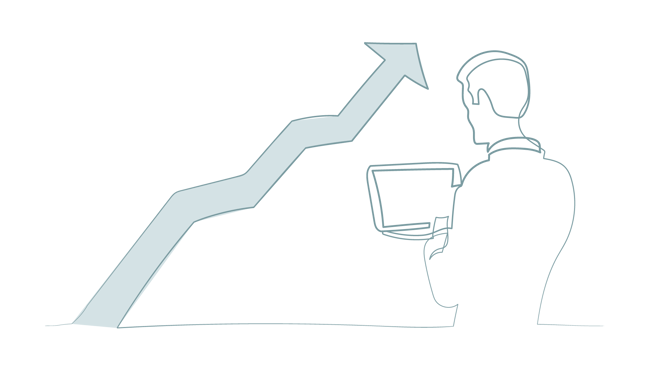Building a successful long-term investment portfolio requires consideration of a number of key factors, including financial goals and the most suitable asset types to include.
If you are considering investing as a way of potentially generating a higher return than that available from a bank or a building society, it is likely you have some questions about how to do this.
This blog post will outline the different types of investments available and how we use these to build investment portfolios to generate a return over the long term.
Please note: As is the nature with investing, your capital is at risk, and you may not receive back the same amount you put in when you choose to cash out your savings. Past performance is not an indication of future performance.

How we build investment portfolios
When we build portfolios for our clients, we consider some key principles:
Know what you own: To forecast portfolio growth accurately, you need to know which companies are in your portfolio. For this reason, we prefer to build portfolios with more weighting towards equities while using other asset types to provide helpful diversification. We believe that taking this approach provides more control of the portfolio, offers improved accuracy when forecasting returns, helps with understanding correlation and makes it easier to reduce risk exposure.
Do not try to time the market: Buying and selling assets when market cycles appear to have peaked will be tempting. However, this can also result in missed opportunities for portfolio growth when investors panic sell or overestimate how well company stock will perform. Missing the best day in the market could cause returns to fall dramatically, so we factor in multiple points in the market cycle when forecasting investment growth, target a median return within a defined volatility range, and accept there will be seasons where some markets do not perform as well as others.
Diversify your investments: Holding a diverse range of assets is critical to building a successful long-term investment portfolio, as spreading your investments across different asset classes, geographies, sectors, and themes reduces dependence on the success of just one market or company to generate profits or returns. We find that this approach provides durability when markets experience volatility and helps to provide a consistent return over the long term by seeking investment growth in different environments.
With these principles in mind, our Investment Managers will suggest a range of asset types to meet our client’s financial goals. Where possible, we will recommend investing assets directly to provide greater transparency and reduce third-party fees.
Sign up to receive the latest news from Killik & Co, including our Market Update and Killik Explains educational videos, and be one of the first to hear about upcoming events and webinars. You can unsubscribe at any time and learn how we use your data in our Privacy Policy.
Sign me up to the latest emails from Killik & Co. We will not share your details with anyone else and you can unsubscribe at any time by clicking “change preferences” at the bottom of our emails.

Types of investments
You can invest in a range of types of investments, including:
- Equities
- Bonds
- Funds
- Alternatives
Each comes with its own risks and rewards, and we would always recommend seeking financial advice from an Investment Manager when it comes to putting your investment plans into action.
Capital at risk.
Please do remember that as with all investments, your capital is at risk and the value of your investments will rise and fall over time. Past performance is not an indication of future performance.
Equities
Equities offer some ownership in a company. This type of investment may also be referred to as Stocks and Shares, as trading takes place in the stock market.
While investing in equities means you may see more volatility in the short term than setting aside savings in cash, it also offers the potential to generate higher variability of return in the short term – in other words, to deliver a greater than expected return as the companies in your investment portfolio experience a period of growth. In addition, economic factors like inflation will have less impact on equities as these are bought and sold in financial markets, which means that investment growth is not solely dependent on bank and interest rates.
The following chart of the FTSE All Share Index, Total Real Return v. Cash Deposit, Real Return shows how returns from equities have historically performed, with inflation taken into account, when compared with holding funds in cash. Through modelling the growth of a £25,000 investment over 48 years, we can see that the invested funds would now be worth over six times as much as the cash value.

Bonds
Bonds are loans that you make to a company or government, which they usually offer with the aim of helping to finance or expand their operations.
A bond may also be referred to as a fixed income security as it will provide investors with a stream of fixed periodic interest payments and the return of their capital at maturity.
In addition, “gilts” is a term that refers specifically to UK Government Bonds issued by the UK Debt Management Office (DMO) on behalf of the UK Treasury to raise finance for public spending.
Both bonds and gilts can assist with portfolio diversification or achieving specific financial goals. As the following chart of the FTSE All Share Index v. Bloomberg Sterling Aggregate Bond Index, Total Returns demonstrates, these asset types tend to return less over the long term than equities, but with significantly lower volatility.

Funds
Funds offer a convenient and efficient way to invest in a basket of well-diversified investments by pooling money with many investors.
Some key benefits of funds include helping to reduce stock-specific risk and ensuring that smaller amounts of capital are invested broadly, which also means your portfolio gains exposure to a wide range of geographies and asset classes.
Funds are usually either active or passive, with the former aiming to beat the market and the latter aiming to deliver returns in line with market performance. Depending on your financial goals, an Investment Manager can recommend the most appropriate funds for your portfolio.

Alternatives
Alternatives covers assets that do not fall into the standard categories of stocks, bonds, funds, and cash.
Examples of alternative investments include venture capital, hedge funds, managed futures, commodities, derivatives, and cryptocurrencies. Real estate may also be considered as an alternative investment.
When appropriate for your financial goals, alternative investments can add useful diversification to a portfolio and could help to reduce investment risk, as performance is typically not correlated to the stock market.

Optimising your investment portfolio
While building an investment portfolio may seem simple, positioning it to deliver long-term investment success* requires significant consideration.
In this blog post, we have outlined how we build investment portfolios to position them for growth over the long term** and explained the role that the different asset types play. However, identifying the most suitable investments for your needs can be a complex process, which makes it critical to educate yourself or seek professional advice before making any decisions.
A successful Investment Manager understands how to build a bespoke portfolio tailored to suit their client’s financial circumstances and goals and is an expert in balancing prospective return projections with targeting a defined volatility range and managing covariance.
For personalised advice on structuring your portfolio to achieve your investment goals, speak to an Adviser.
* As is the nature with all investing, your capital is at risk and you may not receive back the same amount you put in when you choose to cash out your savings.
** Past performance is not an indication of future performance.


